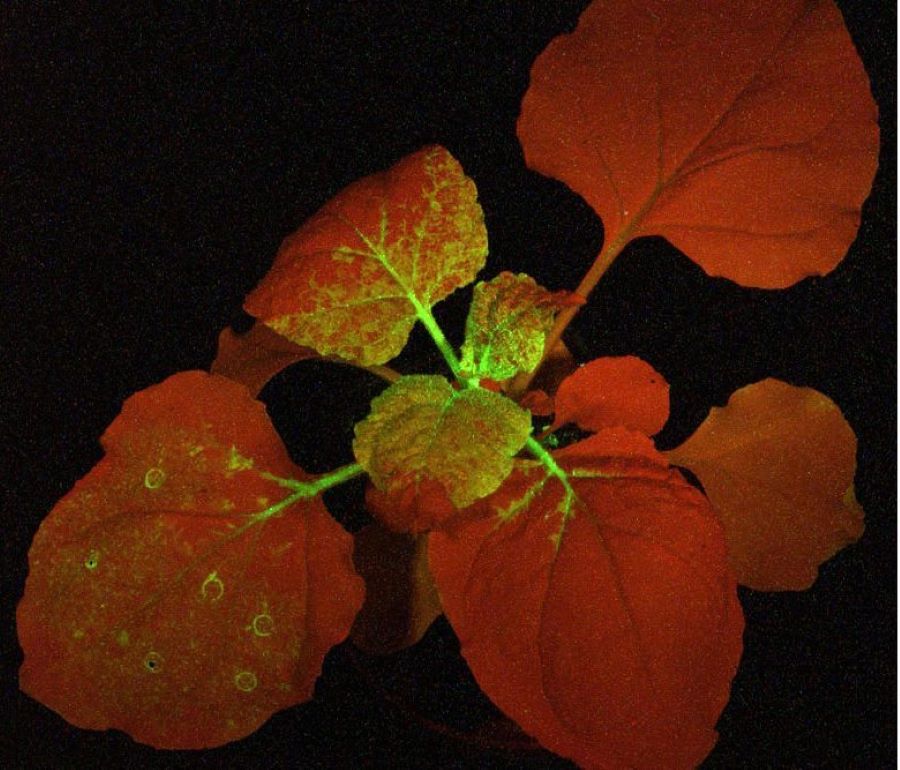LUYOR-3109高强度紫外催化光源促销
LUYOR-3109紫外光源采用了9颗365nm大功率led,安装有二次光学透镜,输出紫外线强度高,...
2024-08-08作者:激发光源事业部时间:2019-12-23 19:29:07浏览4548 次
GFP与生物学家特别感兴趣,因为与大多数其他荧光蛋白不同,GFP自身发出荧光,而无需与其他分子发生任何相互作用。由于它是一种完全由氨基酸组成的蛋白质,因此这意味着可以对生物进行基因工程改造以生产它,从而在生物学的各个领域产生了广泛的应用。
绿色荧光蛋白(GFP)是一种蛋白质,存在于北太平洋发现的水母,维多利亚水母(Aequorea victoria)中。荧光是一种现象,某些物质会吸收电磁辐射(例如光)中的能量,并以不同的波长(通常更长)发射能量。GFP产生的绿色发光是由于它吸收了相对较高能量的蓝色和紫外线发出波长较长,能量较少的绿光。因此,当暴露于不可见的紫外线下时,它会发出绿色光。GFP与生物学家特别感兴趣,因为与大多数其他荧光蛋白不同,GFP自身发出荧光,而无需与其他分子发生任何相互作用。由于它是一种完全由氨基酸组成的蛋白质,因此这意味着可以对生物进行基因工程改造以生产它,从而在生物学的各个领域产生了广泛的应用。
生物发光发生在许多海洋生物中。对于维多利亚水母,化学发光物质称为水母发光蛋白,当它与钙离子结合时会发出蓝光。然后,该光被绿色荧光蛋白吸收,产生绿色发光。已经发现许多其他海洋生物也包含这些物质,但不清楚为什么它们进化产生这种光辉或将颜色从蓝色变为绿色。根据实验证据表明,发光的GFP可以释放电子,一个建议是GFP可以起到光活化电子供体的作用,类似于绿色植物中的叶绿素。
绿色荧光蛋白具有复杂的结构。荧光部分-称为荧光发色团-由三个氨基酸组成,酪氨酸,甘氨酸和丝氨酸或苏氨酸以环状连接。它包含在保护发色团免于与其他分子接触的圆柱形结构中,这对荧光至关重要,因为与水分子接触会消散用于产生绿色光的能量。
事实证明,GFP在遗传学,发育生物学,微生物学和神经病学等领域极为有用。它可用于标记生物体内的特定蛋白质,以查看它们在何时何地表达;生物体DNA的一部分可以对编码目的蛋白的蛋白进行改造,使其也能合成GFP,从而允许使用紫外线在活细胞内跟踪蛋白。也可以通过这种方式标记病毒,从而可以监测活生物体中的感染。还可以对绿色荧光蛋白进行修饰,使其发出其他几种颜色的荧光,从而开辟了新的可能性。其中之一是创建具有在神经元中表达的荧光蛋白的各种组合的转基因小鼠,从而可以详细研究大脑中的神经通路。
在生物学之外还发现了其他应用。一个有争议的发展是荧光宠物的工程。已经产生了产生绿色荧光蛋白的基因工程动物,其中包括鱼,大鼠,猪和兔子。

Green fluorescent protein (GFP) is protein that occurs in a species of jellyfish, Aequorea victoria, which is found in the North Pacific. Fluorescence is a phenomenon whereby certain substances absorb energy from electromagnetic radiation, such as light, and emit the energy at a different, normally longer, wavelength. The green glow produced by GFP results from it absorbing relatively high-energy blue and ultraviolet light and emitting it as green light, which has a longer wavelength and less energy; it will therefore glow green when exposed to invisible ultraviolet light. GFP is of particular interest to biologists as, unlike most other fluorescent proteins, it fluoresces by itself without the requirement for any interaction with other molecules. Since it is a protein made up entirely of amino acids, this means that organisms can be genetically engineered to produce it, giving rise to a wide range of applications in various fields of biology.
Bioluminescence occurs in many marine organisms. In the case of Aequorea victoria, a chemiluminescent substance called aequorin emits blue light when it combines with calcium ions. This light is then absorbed by the green fluorescent protein to produce a green glow. A number of other marine organisms have been found to contain these substances, but it is not clear why they have evolved to produce this glow or to change the color from blue to green. One suggestion, based on experimental evidence that glowing GFP can release electrons, is that GFP could act as a light-activated electron donor, in a similar way to chlorophyll in green plants.
The green fluorescent protein has a complex structure. The fluorescent part — known as a fluorescent chromophore — consists of three amino acids, tyrosine, glycine and either serine or threonine, joined in a ring shape. This is contained within a cylindrical structure that protects the chromophore from contact with other molecules, a feature that is crucial to the fluorescence, as contact with water molecules would otherwise dissipate the energy used to produce the green glow.
GFP has proved to be extremely useful in fields such as genetics, developmental biology, microbiology and neurology. It can be used for tagging specific proteins within an organism in order to see where and when they are expressed; the part of the organism’s DNA that codes for the protein of interest can be engineered to also synthesize GFP, thus allowing tracking of the protein within living cells using ultraviolet light. Viruses can also be tagged in this way, allowing infections in living organisms to be monitored. Green fluorescent protein can also be modified to fluoresce in several other colors, opening up new possibilities. One of these has been the creation of transgenic mice with varying combinations of fluorescent proteins expressed in neurons, which allow neural pathways in the brain to be studied in detail.
Other applications have been found outside biology. One controversial development is the engineering of fluorescent pets. Genetically engineered animals that produce green fluorescent protein have been created, and include fish, rats, pigs and a rabbit.